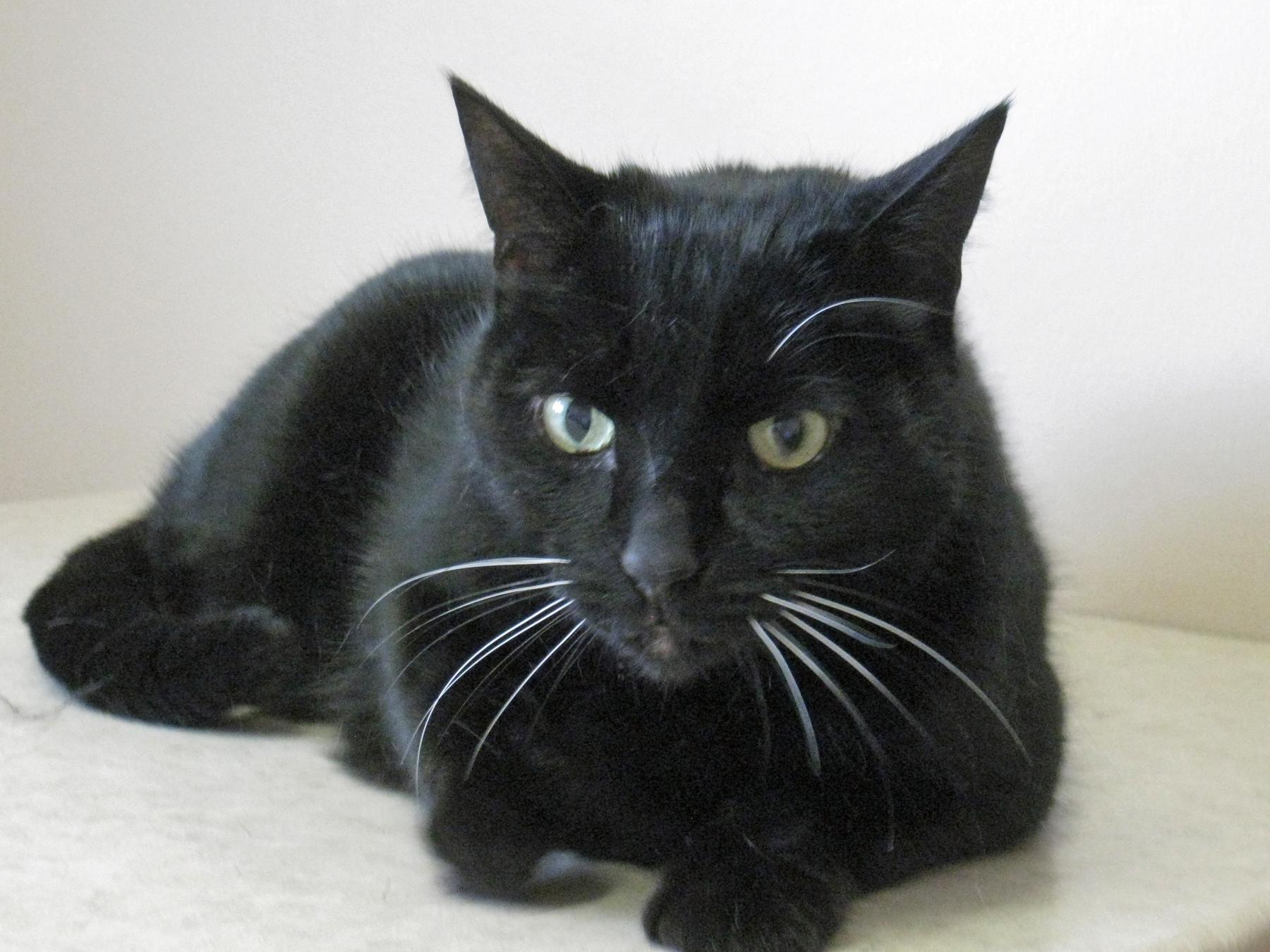Welcome to WebDVM 4. This is your first post. Edit or delete it, then start blogging!
What is Fear Free?
Founded in 2016, Fear Freesm provides online and in-person education to veterinary professionals, the pet professional community, and pet owners. Our courses are developed and written by the most respected veterinary and pet experts in the world, including boarded veterinary behaviorists, boarded veterinary anesthesiologists, pain experts, boarded veterinary internists, veterinary technicians (behavior), experts in shelter medicine, animal training, grooming, boarding and more.
By closely listening to the needs of the profession and those of pet owners, Fear Free has become one of the single most transformative initiatives in the history of companion animal practice, providing unparalleled education on emotional well-being, enrichment and the reduction of fear, anxiety and stress in pets.
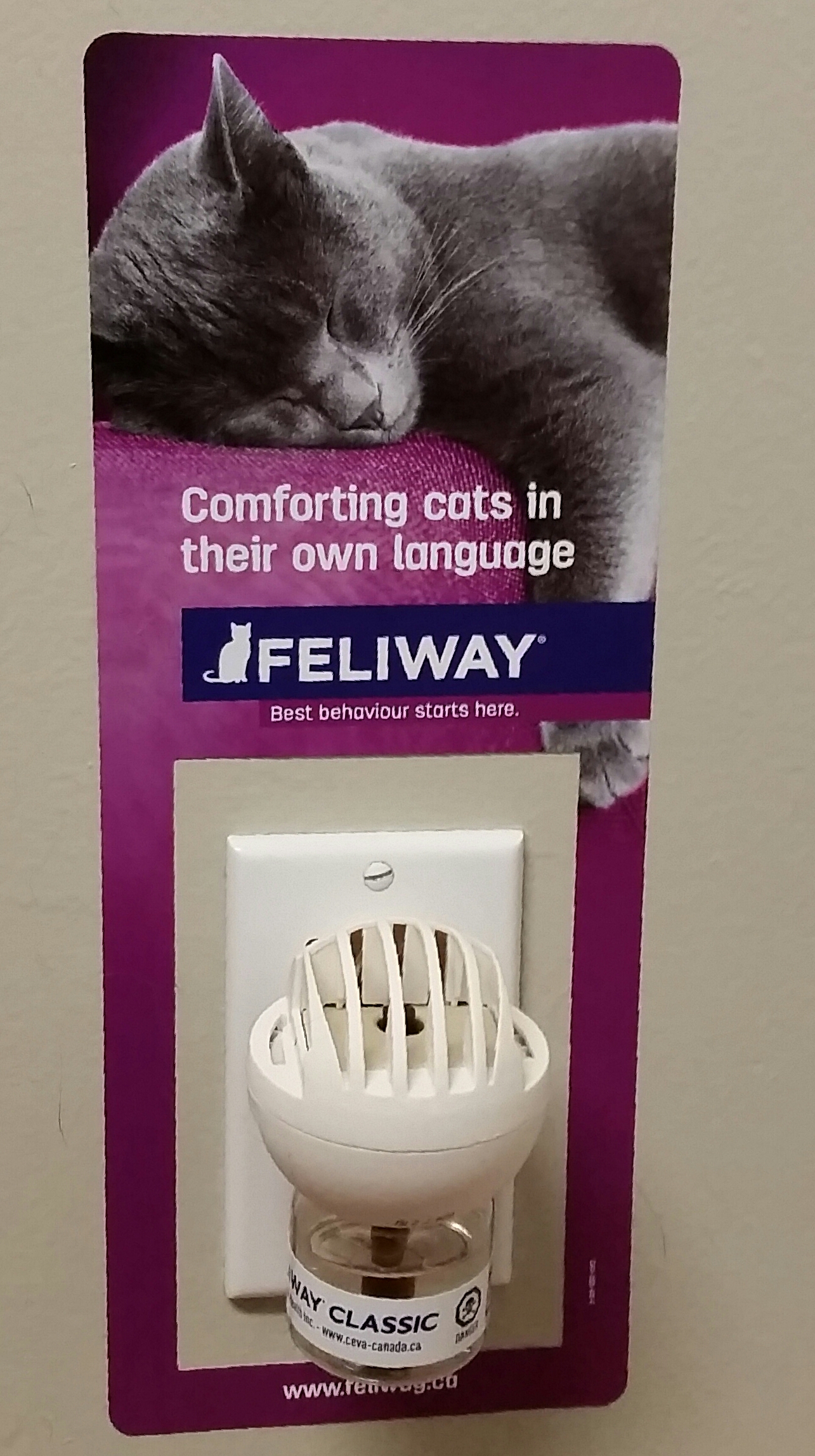
Feliway and Adaptil stories
Kathy :
Many years back my family adopted 2 former barn cats from the Brantford Vet Clinic. They were lovely boys, but one, Felix was (and still is) quite timid and not so sure of his new home. He was peeing around the house. My husband and I were less than thrilled. Dr Seguin suggested we try Feliway Diffusers© in the rooms where they spent most of their time. Feliway Diffusers© plug into an electrical outlet and diffuse a pheromone that helps to calm cats. We don’t notice the smell, but they do. We used the diffusers for a period of 3 – 4 months and the peeing behaviour stopped. We haven’t found it necessary to use all the time, but when my daughter brings her cat for a visit we always make sure to have Feliway © on hand. We also use the Feliway ©spray on the towels in the cat carriers. We spray about ½ an hour before putting either cat in their carrier and it helps make the drive to the vet’s office a little easier for both the cats and I.
Cathy: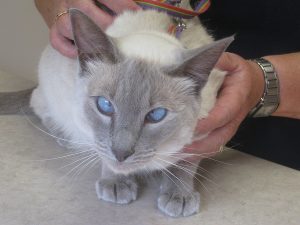
Our receptionist, Bev, had two Siamese littermates. They had been together their whole lives, and were getting to be quite aged. When one passed the other was lost. She went around the house searching for her sister, and crying – you know the Siamese yowl. All day and all night. At first everyone was so sorry for her and her loss; but after several days of crying they were at their wits end, not being able to sleep. We told her to put a Feliway Diffuser© into the house in the area where she spent her time. In surprisingly short order the yowling decreased, and then stopped. By the time the diffuser ran out, in a month, she had made the adjustment and had settled into her new life.
Christina: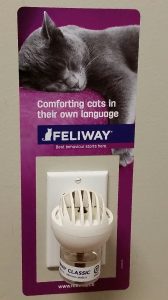
In our exam room at the clinic we have a Feliway diffuser © plugged in to help our kitty patients. We use the diffuser to help decrease anxiety and stress during the vet visit. For our feline patients who show more signs of being nervous and stressed, we will use the Feliway spray© on a towel on the table and even spray our clothing. We have seen improvements in our patients using these techniques.
And on the dog side:
In our dog exam room at the clinic we have an Adaptil diffuser© plugged in to help our canine patients. This is used to help decrease anxiety and stress during the vet visit. For our dogs that are showing more signs of anxiety and stress we have been spraying bandanas with Adaptil© and putting them on our canine patients to help them feel calm and safe. We have seen less trembling/shaking and panting during appointments using this method.

If you are looking for information on licensing your dog, click the link below. There are changes in the regulations for new dogs versus renewals.
http://www.brantford.ca/residents/family/Pages/AnimalServicesLicensing.aspx

is very pleased to introduce starting Monday November 9th…..
PET HEALTHCARE PLANS
- Affordable Monthly Payments
- all necessary vaccines
- low exam co-pays
- unlimited nail trims
- discount on additional services
We all want to give our pets the best possible care. Dividing those services into 12 monthly payments would make it more convenient for many of us.
Ask one of our team members which Preventive Care Plan is right for your pet – and enroll today!
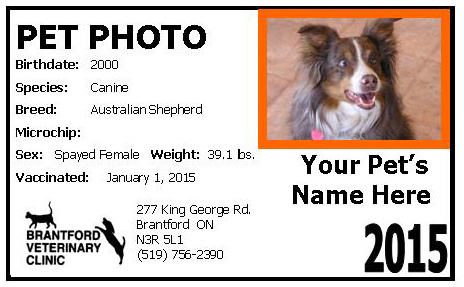
We are making some changes to the way we do Photo ID’s!
We hope you enjoy receiving your Pet’s ID cards as much as we enjoy producing them. We have come to realize that most pets don’t change too much from year to year — so our new plan is to produce ID cards at the “Milestone Years”.
This would mean:
1 at 1 year (or the 1st year we meet your pet)
1 at 5 years (We’re a mature adult now)
1 at 8 years (We’re well into middle age)
1 at 10 years and every year after because
we’re seniors and we deserve it.
If at any year in between you would like to receive a card—please let us know and we will be happy to take your pet’s picture and produce a card for you.
This handsome 10 year old indoor cat ran out the door as his owners were leaving on vacation. Despite their best efforts they were unable to catch him and he was missing for 6 weeks. They had given up hope of ever seeing him. He was found about 5 kilometers from his home by some people who were considering keeping him. He was taken to a veterinarian’s office and scanned for a microchip and, lucky for him and his family, he had one. His owners were contacted and were able to bring him home.
Have you considered talking to your veterinarian about microchipping your pet(s)? It can be done at your next visit, right in the exam room.
Make sure they find their way home!
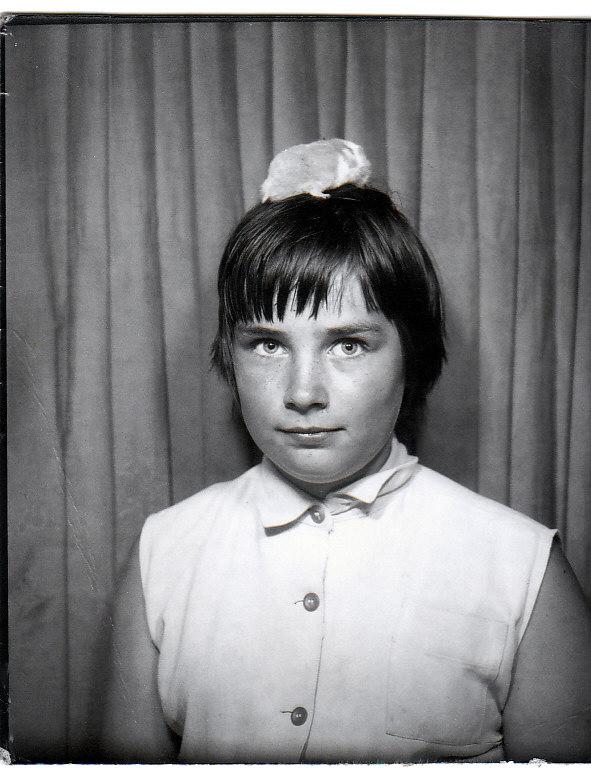
When I was just 8 years old I went to see Born Free at the drive in. I was very impressed with the film and the message that it carried. It was worth the risk, the effort and the time to ensure the lions were able to live freely. Could anything be more important? Not in my young mind.
My mother was soon very sorry that she had taken me. Anyone who has had a hamster knows that they seem to spend their entire time trying to break free; from chewing the bars, climbing the walls and forever running that wheel in an effort to get somewhere. After having watched the movie I found it hard to watch the efforts. I decided that my hamster needed to be “Free”. I would close my bedroom door and open the cage. Seemed very innocent until we discovered that Peanuts had chewed through the bottom of my dresser and climbed up into my drawers, making a nest of my lovely lambs wool sweater. My mother was not impressed.
Before long a room did not seem to be enough. I let him come with me into other areas of the house. Unfortunately, I lost him for a few days. My mother was much less than impressed to realize that he had chewed his way into the couch and was living in the cushions. I needed to think of something else.
Surely hamsters were entitled to experience the natural world! Fortunately even I knew that hamsters are fast movers and couldn’t just be let go. I fashioned a leash for him and took him outside, into the grass and the sun. I felt good being able to offer him the experience. Soon he was going many different places with me. I took him to the mall and have photo booth pictures with him and a good friend. Remember, I was just 9 years old and it didn’t seem unusual. You know there had to be a climax to these events.
I took music lessons. It required a bus ride, with a connection. Why did I honestly think I should take Peanuts with me? My mother never got a good answer to that question. I carried him in my coat pocket. All went well until I was nearly home. I put my hand into my pocket and found a chewed hole through the lining – Peanuts was missing!!! I was extremely distraught. My long suffering mother called the bus station and was happy to report that he had been found. The driver was very surprised to find a hamster on his bus, but impressed with how easily he could handle him, how social he was. He said that he was glad that he could go back to his owner, but was disappointed that he couldn’t keep him. Peanuts was quite the character.
Mom drove to the bus driver’s house to collect him. I was very disappointed not to go, but it was time to get ready for bed. In her urgency she didn’t think to bring a carrier cage. Where to put him to bring him home? Obviously a pocket was not the best idea. She put him in the glove compartment. Imagine her surprise to find him gone when she got home. It was very late so she locked the doors and hoped he would reappear by morning.
No such luck. Come morning, on further investigation, it was determined that there was an opening in the glove box that allowed him to climb under the dash. You could hear the rustle as he moved around. I was terrified that if the car were started he might be hurt. Fortunately, my brothers were mechanically inclined and we were able to get Peanuts back.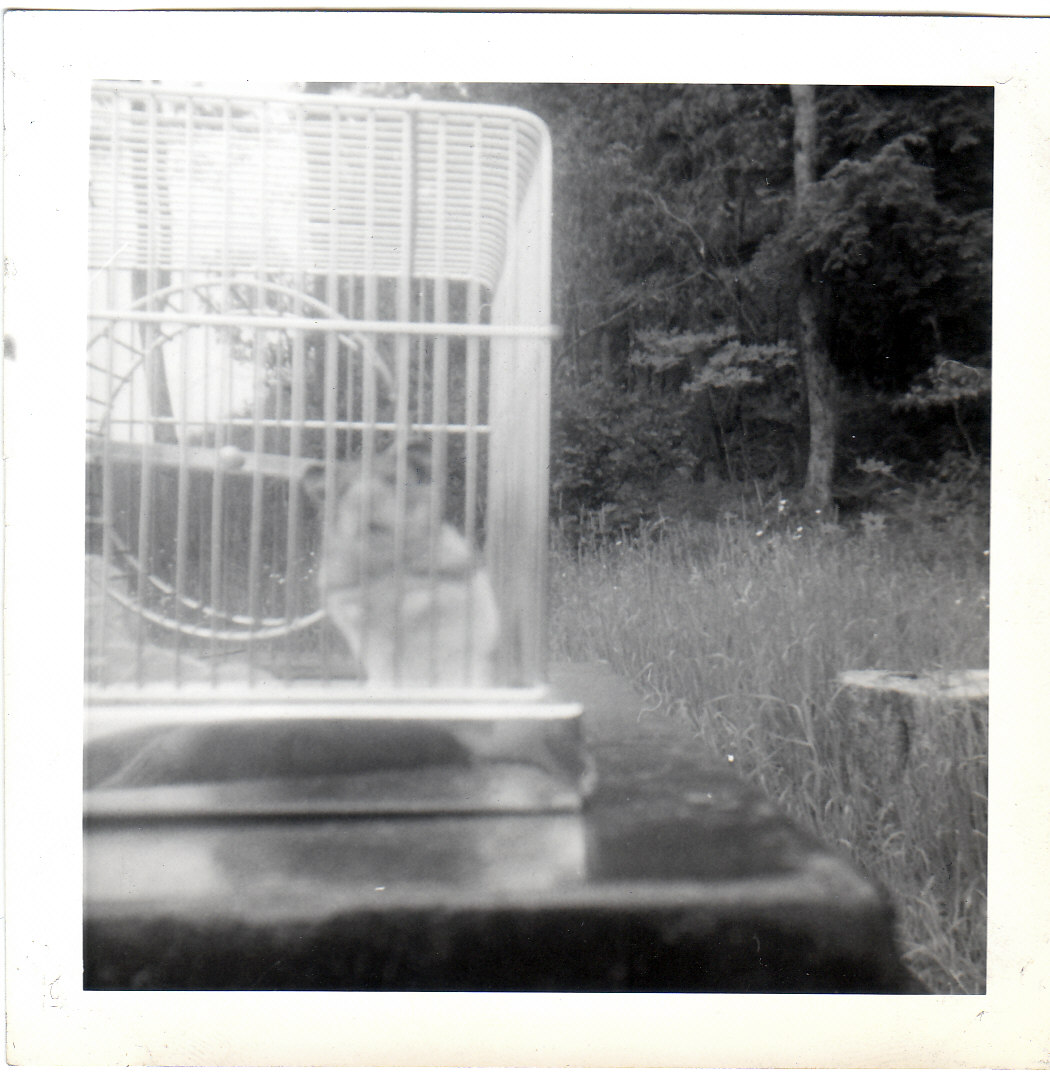
At that point, under unquestionable reason, my hamster’s freedom was curtailed and I began to learn the concept of reasonable compromise.
Cathy Seguin, DVM

Euthanasia, A touchy subject.
I would like to take a moment to talk briefly about a very touchy subject. Many times we field calls from people who are enquiring as to the cost of euthanizing a family pet. While we understand that this is a very emotional subject, we do have a policy that we require a client relationship in order to perform this service. Some people find this upsetting, but let me outline a few of the situations that can arise and see if it helps to bring a better understanding. These are situations that have happened in veterinary clinics in the past, not necessarily this one.
Situation A: Husband brings in the dog, Fluffy for euthanasia. Fluffy belongs to the wife, or another family member who do not wish, or are not ready, for this to happen.
Situation B: Family member is caring for a cat that urinates inappropriately and thinks their son/daughter/mother/father would be better off without having to deal with the problem.
Situation C: A divorce has taken place and the family pet is used as a bargaining chip – or way to get back at spouse.
Situation D: A neighbor is angry that your cat eliminates in his/her yard – or that your dog gets loose and causes damage or too much noise.
By having a known history with your pet, we will rule out a health concern that may give you more time to enjoy your family pet. A cat was once brought in for euthanasia for urinating all over the house. We determined that there was a bladder infection and prescribed antibiotics instead.
If we have a client relationship, we have the names on file of people who are authorized to make this type of decision. If we do not have your spouse’s name on the file, we will call and speak to the person whose name is on the file. If there is more than one person authorized to make decisions for your pet, simply make sure we have their name on record.
I hope this gives you some understanding as to why we require a client relationship
This past weekend was a sad one for me. I had to perform one of the most difficult tasks in veterinary medicine…. euthanasia for an ailing dog or cat. I helped Fraulein, a grey faced Golden Retriever, and Lacey, a weakened Jack Russell Terrier, leave this world without unnecessary suffering.
Euthanasia in a dog or cat is the humane solution to end suffering.
This is not the standard definition, but it’s what euthanasia means to me as a veterinarian. Pet euthanasia is the humane termination of an animal’s life when there is no more merciful option.
It’s hard to do. It’s hard for the doctor. It’s hard for the pet’s family. But, fortunately, it’s not hard for the patient.
What is the Process of Pet Euthanasia?
There are different methods of terminating an animal’s life, some more humane than others. Due to updated guidelines on euthanasia and with the development of better medications, the process can be very peaceful and painless.
The best drugs actually “put the pet to sleep.” In other words, the patient lapses into a deep sleep or coma-like state so he is unaware when his body systems shut down. He won’t feel his heart stop or panic when he stops breathing. Organs may take a while to cease functioning, but the brain doesn’t recognize the actual time when it occurs. This lack of awareness makes euthanasia quite peaceful for the patient.
Should You Stay or Go During Euthanasia for Your Dog or Cat?
Many families ask my advice on whether they should be with their pet as his life ends and my feeble response is, “It depends.” It depends on your personal feelings. Ask yourself these questions when contemplating the end of life plan for your pet. It’s best to answer these questions before you are actually in the situation. That way you make objective, not emotional, decisions. So no matter how young or healthy your pet is, consider these questions:
- Do I want my last memory to be of her breathing in my arms?
- Do I want my last memory to be of him taking his last breath in my arms?
- Do I want the euthanasia performed at home or at the veterinary hospital?
- Are my children mature enough to understand why we are performing euthanasia?
- Do my children need to actually experience the end or will a respectful acknowledgment after death be sufficient closure?
- Do I want to bury my pet at home or in a pet cemetery?
- Do I want my pet cremated? Do I want his ashes returned to me?
- Is there a pet grief counselor available should I choose to see one?
 Cat or dog euthanasia is respectful, peaceful and painless with proper preparationn for a loving pet who is now suffering
Cat or dog euthanasia is respectful, peaceful and painless with proper preparationn for a loving pet who is now sufferingThe end of a life is a sad event, but it can be respectful and peaceful and painless with a little counseling and preparation. Here are some of the things I talk about before euthanizing a family pet.
If pet owners want to be with their pet, I give them the option of having the euthanasia performed at our clinic or in their homes. I place a catheter in the pet’s vein to aid in the intravenous administration of the medication. I give the family ample time for good-byes. I make sure they understand that the medication works quickly and its effects cannot be undone. I explain that any vocalizations, twitches, or loss of bladder/bowel control are due to reflexes and the pet is unaware of these occurrences.
Then we gather around the pet and comfort her while giving her a gracious end. I often tell clients that euthanasia may be the hardest thing they will ever do, but it may also be the most generous gift they will ever give their pet.
The End of My Week
My sad week involved two euthanasias performed exactly 7 days apart…both on Sundays. Death doesn’t refer to a calendar or watch a clock. It was time… time for Fraulein and Lacey to say good-bye to their families. They brought joy to the people that loved them. Their families loved them back by making their lives the very best they could be until the very end.
Are you struggling with a euthanasia decision for your senior or ailing pet? We’re happy to help.


